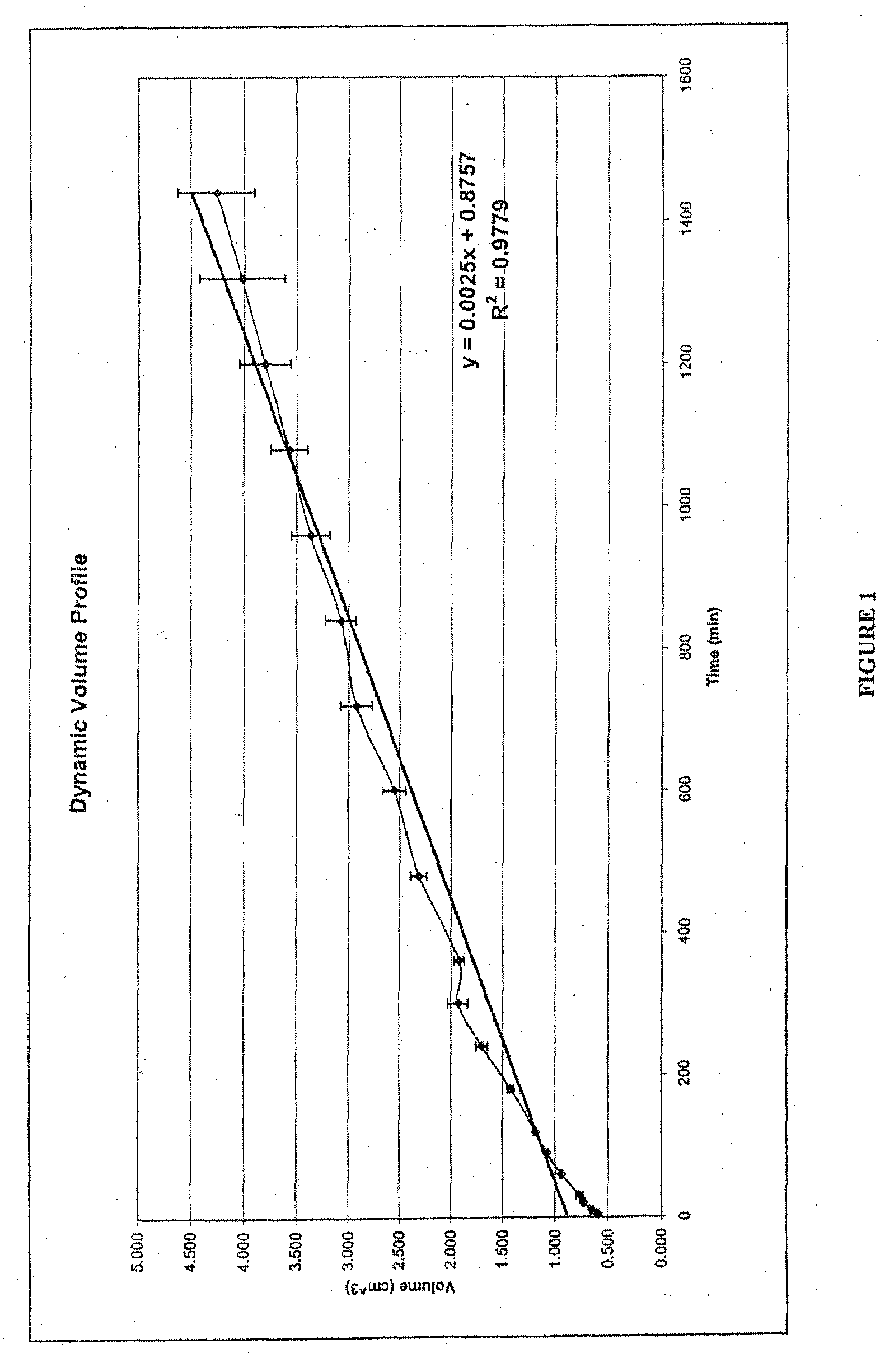Hydrostatic delivery system for controlled delivery of agent
a delivery system and controlled delivery technology, applied in the direction of packaged goods, organic active ingredients, non-active ingredients of pharmaceuticals, etc., can solve the problems of increased manufacturing costs, patient safety is jeopardized, and systems are generally known to lack the ability to release pharmaceutical agents according to the law
- Summary
- Abstract
- Description
- Claims
- Application Information
AI Technical Summary
Benefits of technology
Problems solved by technology
Method used
Image
Examples
example 1
Preparation of Hydrostatic Couple
[0104]The hydrostatic couple is prepared either by dry screening the components of group-A and group-B compounds followed by geometric blending of components to form an intimate mixture, or granulating the components to form discrete aggregates. The agent of interest is prepared and combined with the hydrostatic couple. This may be achieved by blending or further re-granulation to homogeneity. The resulting mixture is compressed on a B or D type tablet press to form a compact. Such compacts may be further coated if desired using standard techniques as known within the art.
[0105]A manufacturing process for a hydrostatic delivery system in form of a matrix tablet involves the following general steps:
[0106]a) Preparation of group-A component(s);
[0107]b) Preparation of group-B component(s);
[0108]c) Preparation of agent of interest formulation;
[0109]d) Blending a)-c);
[0110]e) Compressing the blend into a suitable compact;
[0111]f) Coating the compact with ...
example 2
[0117]Two drug delivery systems were prepared in order to compare the kinetics of drug release and changes in dynamic volume profile of the delivery system (tablet). The control comprised a prior art formulation, (Prior Art, Table 1) and the second delivery system comprised the hydrostatic couple (components listed in Table 1) as prepared using the method of Example 1. The agent of interest in both delivery systems was caffeine.
TABLE 1Components of Prior art and hydrostatic couple formulationsAmount per tabletComponentComponent(mg)Prior artActive agentCaffeine Anhydrous160USPControl ReleaseCarbopol 971P USP / NF224polymerFlow PromoterColloidal Silicon Dioxide12LubricantMagnesium Stearate4Hydrostatic coupleActive agentCaffeine Anhydrous USP70Hydrostatic coupleGroup-ACarbopol 971P280Group-BCrospovidone XL-108Flow promoterColloidal Silicon Dioxide4.3LubricantMagnesium Sterate3.67Group-BCrospovidone XL-108Flow promoterColloidal Silicon Dioxide4.3LubricantMagnesium Stearate3.67
[0118]The pr...
examples 3-6
[0132]In these examples hydrostatic delivery systems for extended release formulation of various therapeutic agents are presented. Two formulations (Formula 1 and Formula 2) are used to illustrate how the hydrostatic couple as described herein can be used to achieve zero-order kinetics and predictably different release rates. Formula 1 exhibits faster rates of drug release than that observed with Formula 2. The rate of release of the agent of interest may be selected considering several variables, for example, but not limited to the solubility of the agent of interest, and pharmacological activity of the agent of interest. For example, with decreased solubility of an agent of interest, faster release of the agent may be desired, such as that provided by, for example, but not limited to, using a hydrostatic couple as provided in Formula 2. It is to be understood, however, that the formulation of the hydrostatic couple may be varied as required to obtain a desired rate of release of a...
PUM
| Property | Measurement | Unit |
|---|---|---|
| weight % | aaaaa | aaaaa |
| diameter | aaaaa | aaaaa |
| viscosity | aaaaa | aaaaa |
Abstract
Description
Claims
Application Information
 Login to View More
Login to View More - R&D
- Intellectual Property
- Life Sciences
- Materials
- Tech Scout
- Unparalleled Data Quality
- Higher Quality Content
- 60% Fewer Hallucinations
Browse by: Latest US Patents, China's latest patents, Technical Efficacy Thesaurus, Application Domain, Technology Topic, Popular Technical Reports.
© 2025 PatSnap. All rights reserved.Legal|Privacy policy|Modern Slavery Act Transparency Statement|Sitemap|About US| Contact US: help@patsnap.com



